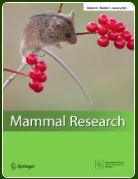Unified analysis of niche overlap between coyotes (Canis latrans) and gray foxes (Urocyon cinereoargenteus)
César R. Rodríguez-Luna, David Valenzuela-Galván, Jorge Servín, Rurik List

Mamm Res (2024).
https://doi.org/10.1007/s13364-024-00773-y
Abstract
The dynamics of coexistence among species sharing resources in the same space is a key aspect of understanding their ecological interactions, which can influence their distribution and fitness. The quantification of niche overlap allows us to elucidate the coexistence relationships among species, as this measure can be considered indicative of resource partitioning and potentially highlights competition within a particular habitat. The ecological strategies that promote coexistence are not fully described for many sympatric species, including common and widely distributed species such as coyotes (Canis latrans) and gray foxes (Urocyon cinereoargenteus) in North America. For these species, our interest was to determine the similarity of their ecological niches and identify which of the main axes (i.e., spatial, trophic, temporal) had the greatest influence on differentiation in temperate forests. Given both species’ sympatry and similar ecological roles, we expected to find significantly different ecological niches but with high overlap. Additionally, we anticipated that the temporal axis would have the greatest influence on niche segregation, as has recently been described for these species in the area. To investigate this, we conducted a unified analysis of niche overlap between coyotes and gray foxes in temperate forests, averaging data from the spatial, trophic, and temporal niche axes. The unified analysis revealed significant differences in the niche spaces of coyotes and gray foxes, despite a high overlap between them, the daily activity patterns (temporal axis) was the variable that had the most influence on niche segregation. The dynamics of resource partitioning in temperate forests between coyotes and gray foxes are complex. Despite the high degree of niche overlap, coexistence is facilitated by differentiation across the main ecological niche axes at different scales, with the most pronounced segregation occurring along the temporal axis and, to a lesser extent, through fine-scale segregation along the spatial and trophic axes.